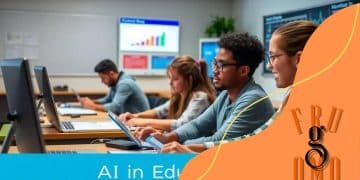AI tools for special education: unlocking potential

AI tools for special education enhance learning by providing personalized experiences, improving engagement, and supporting teachers, while addressing challenges like data privacy and accessibility.
AI tools for special education offer groundbreaking opportunities to improve learning outcomes for students with diverse needs. Have you ever wondered how technology can tailor education to individual strengths? Let’s dive into the impact of these innovative tools.
Understanding AI tools in education
Understanding AI tools in education is essential for both teachers and students. These tools can transform the traditional learning environment, making it more interactive and tailored to individual needs. Let’s explore how these innovations are reshaping classrooms.
What are AI tools?
AI tools refer to software and applications that utilize artificial intelligence to assist in educational settings. They can analyze data, identify learning patterns, and even personalize learning experiences for students.
Benefits of AI tools
Implementing AI tools in education offers numerous advantages:
- Personalized learning experiences that adapt to each student’s pace.
- Improved engagement through interactive content.
- Automated administrative tasks, freeing up teachers’ time for more direct student interactions.
The role of these tools extends beyond simple automation. For example, they can provide real-time feedback to students, which enhances the learning process. Additionally, teachers can using AI tools to create customized lesson plans that cater to the diverse abilities in their classrooms.
Furthermore, educators can leverage AI technology to identify at-risk students early on. This proactive approach can lead to timely interventions, ensuring that all learners have the support they need to succeed.
Examples of AI tools
Here are some popular AI tools used in education:
- Kahoot! – An engaging platform for quizzes and interactive lessons.
- Duolingo – An app that personalizes language learning based on user performance.
- IBM Watson Education – A tool that helps educators analyze student data to improve outcomes.
With the ongoing advancement of technology, the potential applications of AI in education are limitless. Teachers are encouraged to explore these tools to enhance their teaching methods and elevate student learning experiences.
Benefits of AI for special education
Benefits of AI for special education are vast and transformative. These tools help break down barriers for students with diverse learning needs. By delivering personalized support, AI can enhance learning experiences for every child.
Personalized Learning Experience
One of the main advantages of AI in special education is the ability to tailor learning experiences. Each student can learn at their own pace, which is crucial for those who may struggle with the traditional classroom setting.
Increased Engagement
Another benefit is the boost in student engagement. AI tools often use interactive methods, like games and simulations, that keep students interested. For some learners, this engagement can lead to greater participation and improved outcomes.
Moreover, AI can help identify individual strengths and weaknesses by analyzing student performance data. This ongoing assessment allows educators to modify their teaching techniques to meet specific needs. Teachers can spend more time focusing on areas that require attention instead of covering generic content.
Support for Teachers
AI tools also relieve educators from administrative burdens. Tasks such as grading can be automated, freeing teachers to focus on instruction and relationship-building with students. Furthermore, AI can provide insights that teachers may not notice on their own.
Another important aspect is that AI technology can assist in creating customized resources for students. For example, it can generate visual aids, worksheets, or unique lesson plans tailored to a student’s learning style.
Accessibility Improvements
Accessibility is a major concern in special education. AI tools can offer solutions that make content more accessible. For example, text-to-speech features or assistive technologies break down barriers for students with disabilities.
In summary, the benefits of AI in special education not only enhance learning experiences but also empower educators to support their students more effectively. With the right tools, the educational landscape can become more inclusive and supportive for all learners.
How to implement AI tools effectively

How to implement AI tools effectively in the classroom can make a significant difference in education. Knowing the right steps to take ensures that both educators and students benefit maximally from these advancements.
Assess Needs and Goals
The first step in implementation is to assess the specific needs of your classroom. What challenges do your students face? Establish clear goals for what you hope to achieve with AI tools. This will help guide decisions on which tools to integrate.
Choose the Right Tools
Not all AI tools are created equal. Research and select tools that align with your educational objectives. Some popular options include:
- Kahoot! for interactive quizzes and learning games.
- DreamBox for personalized math learning.
- Read&Write for literacy support, especially for struggling readers.
Look for ease of use and compatibility with existing curricula. Pilot a few tools to see how they fit within your classroom environment.
Train Educators and Students
Training is essential for successful AI tool implementation. Conduct training sessions for teachers so they feel comfortable using the new technology. Provide resources, such as guides and tutorials, to help them learn.
Equally important is training students. Teach them how to effectively use the tools to aid their learning. This empowers them to take charge of their educational journey.
Monitor Progress and Adapt
Once tools are in place, it’s crucial to monitor their impact. Collect data on student performance and engagement. Use this information to adapt approaches as needed. For example, if a particular tool isn’t meeting your goals, don’t hesitate to explore alternatives.
As technologies evolve, remain flexible and open to change. Stay updated on new AI developments that can enhance your educational practices.
Involving both teachers and students in the process ensures that everyone has a stake in the successful integration of AI tools, paving the way for a more enriched educational experience.
Real-life examples of AI in special needs
Real-life examples of AI in special needs education showcase how technology can change lives. These applications highlight the potential of AI to support individualized learning and accessibility for students who face challenges.
Speech Recognition Tools
Speech recognition tools, such as Dragon NaturallySpeaking, empower students with speech difficulties. These tools allow them to communicate effectively by converting spoken words into text. This can significantly boost their confidence and participation in discussions.
Personalized Learning Platforms
Platforms like DreamBox Learning provide personalized math instruction tailored to each student’s pace and learning style. By adjusting to the learner’s needs, these platforms foster a more engaging educational experience.
Assistive Technologies
Assistive technologies are vital for supporting students with disabilities. For example, text-to-speech programs can help students with reading difficulties to access written materials more easily. This feature enhances comprehension and engagement with the curriculum.
Another effective tool is Ghotit, which helps students with dyslexia improve their spelling and writing skills. It offers suggestions and corrections based on individual writing patterns, making writing tasks less daunting.
Block-based Coding Programs
Block-based coding programs, such as Scratch, have proven successful in teaching coding concepts to students with special needs. These programs use visual blocks, making coding more accessible. This not only enhances their critical thinking skills but also boosts their self-esteem as they create projects.
In classrooms, educators have found that incorporating these AI tools can lead to significant improvements in student outcomes. Students often show increased motivation and better academic performance as they gain access to tailored educational supports.
These examples of AI in special education illustrate the transformative power of technology. By implementing these tools, educators can create a more inclusive environment that meets the diverse needs of all learners.
Challenges of using AI in education
The challenges of using AI in education can be significant and multifaceted. While the potential benefits are vast, understanding the hurdles is essential for effective integration.
Data Privacy Concerns
One major challenge is related to data privacy. AI tools often require access to student data to function effectively. Concerns regarding how this data is collected, stored, and used can make educators and parents anxious. Ensuring stringent data protection protocols is necessary to build trust.
Accessibility Issues
Despite advances in technology, there are still accessibility issues faced by some students. Not all students have equal access to the technology required to use AI tools. Disparities in resources can lead to inequalities in educational opportunities.
Technical Challenges and Training
Implementing AI tools often requires technical knowledge that may not be readily available in every school. Teachers may need significant training to effectively use these technologies. Without proper training, tools may not be used to their full potential, which can lead to frustration and disengagement.
Furthermore, integrating AI into established teaching methods can be complex. Educators must find ways to blend traditional techniques with new technologies seamlessly. This blending requires time and effort.
Dependence on Technology
An over-reliance on AI tools can lead to a lack of critical thinking and problem-solving skills among students. If students become too dependent on technology for answers, they may struggle to develop their own reasoning abilities. Thus, it’s essential to strike a balance in using AI tools while encouraging independent thought.
Ethical Considerations
Lastly, ethical considerations must be taken into account. Decisions made by AI algorithms can sometimes be influenced by biases in the data they are trained on. It is critical for educators to remain vigilant and aware of these biases to ensure fair and equitable learning experiences.
By recognizing and addressing these challenges, educators can work towards a more effective implementation of AI in education, balancing technology use with the essential human aspects of teaching and learning.
FAQ – Frequently Asked Questions about AI in Special Education
What are the main benefits of AI in special education?
AI provides personalized learning experiences, enhances engagement, and supports teachers by automating tasks, allowing them to focus on their students.
What challenges do educators face when implementing AI?
Challenges include data privacy concerns, accessibility issues for students, the need for adequate training, and balancing technology with traditional teaching methods.
How can AI tools improve learning outcomes?
AI tools analyze student data to tailor education, identify strengths and weaknesses, and provide individualized support, ultimately boosting performance.
Are there examples of AI tools used in special education?
Yes, tools like speech recognition software, personalized learning platforms, and assistive technologies are commonly used to aid students with special needs.





